A Power Processing Circuit for Indoor Wi-Fi Energy Harvesting for Ultra-Low Power Wireless Sensors
Abstract
:1. Introduction
2. The Proposed Power Processing Circuit for the Radio Frequency Energy Harvesting System (RFEHS)
2.1. The General Block Diagram
2.2. The Schematic Circuit
3. Analytical Analysis
3.1. The Equivalent Circuit
3.2. Matched and Unmatched Antenna-Rectifier Circuit
3.3. Rectifier Circuit Impedance Analysis
4. The Rectifying and Boost Circuit Characteristics
5. Simulation Results of the Power Processing Circuit
6. The Proposed Power Processing Circuit Performance
7. Actual Experimentation of the RFEHS
8. Harvesting System Performance Comparison
9. Conclusions
Acknowledgments
Author Contributions
Conflicts of Interest
References
- Shenghua, Z.; Nanjian, W. A novel ultra low power temperature sensor for UHF RFID tag chip. In Proceedings of the ASSCC’07. IEEE Asian Solid-State Circuits Conference, Jeju, Korea, 12–14 November 2007; pp. 464–467. [Google Scholar]
- Visser, H.J.; Vullers, R.J. Wireless sensors remotely powered by RF energy. In Proceedings of the 2012 6th European Conference on Antennas and Propagation (EUCAP), Prague, Czech Republic, 26–30 March 2012; pp. 1–4. [Google Scholar]
- Zou, X.; Xu, X.; Yao, L.; Lian, Y. A 1-V 450-nW fully integrated programmable biomedical sensor interface chip. IEEE J. Solid State Circuits 2009, 44, 1067–1077. [Google Scholar] [CrossRef]
- Urard, P.; Romagnello, G.; Banciu, A.; Grasset, J.C.; Heinrich, V.; Boulemnakher, M.; Todeschni, F.; Damon, L.; Guizzetti, R.; Andre, L.; et al. A self-powered IPv6 bidirectional wireless sensor & actuator network for indoor conditions. In Proceedings of the 2015 Symposium on VLSI Circuits (VLSI Circuits), Kyoto, Japan, 17–19 June 2015; pp. 100–101. [Google Scholar]
- Mimis, K.; Gibbins, D.; Dumanli, S.; Watkins, G.T. Ambient RF energy harvesting trial in domestic settings. IET Microw. Antennas Propag. 2014, 9, 454–462. [Google Scholar] [CrossRef]
- Lu, X.; Wang, P.; Niyato, D.; Hossain, E. Dynamic spectrum access in cognitive radio networks with RF energy harvesting. IEEE Wirel. Commun. 2014, 21, 102–110. [Google Scholar] [CrossRef]
- Liao, Y.; Zhang, Y.; Cai, K.; Gao, W. A Simple Equivalent Circuit for Small RFID Tag Antennas in Low Loss Dielectric Materials. In Applied Mechanics and Materials; Trans Tech Publication: Stafa-Zurich, Switzerland, 2013; pp. 1470–1473. [Google Scholar]
- Sum, Y.L.; Soong, B.H.; Tseng, K.J. Selection of unit cell size for RF energy harvesting metaresonator array. In Proceedings of the 5th IET International Conference on Renewable Power Generation (RPG), London, UK, 21–23 September 2016. [Google Scholar]
- Choi, M.; Jang, T.; Jeong, J.; Jeong, S.; Blaauw, D.; Sylvester, D. A Resonant Current-Mode Wireless Power Receiver and Battery Charger With -32 dBm Sensitivity for Implantable Systems. IEEE J. Solid State Circuits 2016, 51, 2880–2892. [Google Scholar] [CrossRef]
- Masuch, J.; Delgado-Restituto, M.; Milosevic, D.; Baltus, P. Co-integration of an RF energy harvester into a 2.4 GHz transceiver. IEEE J Solid State Circuits 2013, 48, 1565–1574. [Google Scholar] [CrossRef]
- Mrnka, M.; Vasina, P.; Kufa, M.; Hebelka, V.; Raida, Z. The RF Energy Harvesting Antennas Operating in Commercially Deployed Frequency Bands: A Comparative Study. Int. J. Antennas Propag. 2016. [Google Scholar] [CrossRef]
- Sample, A.P.; Parks, A.N.; Southwood, S.; Smith, J.R. Wireless ambient radio power. In Wirelessly Powered Sensor Networks and Computational RFID; Springer: Berlin, Germany, 2013; pp. 223–234. [Google Scholar]
- Shashkin, V.I.; Murel, A.V. Comparative analysis of microwave low-barrier Mott and Schottky detector diodes. In Proceedings of the 20th International Crimean Conference on Microwave and Telecommunication Technology (CriMiCo), Sevastopol, Ukraine, 13–17 September 2010; pp. 829–830. [Google Scholar]
- Kadir, E.A.; Hu, A.P.; Biglari-Abhari, M.; Aw, K.C. A bridgeless rectification circuit for Wi-Fi energy harvesting system. In Proceedings of the IEEE Energy Conversion Congress and Exposition (ECCE), Montreal, QC, Canada, 20–24 September 2015; pp. 421–426. [Google Scholar]
- Bandyopadhyay, S.; Mercier, P.P.; Lysaght, A.C.; Stankovic, K.M.; Chandrakasan, A.P. A 1.1 nW energy-harvesting system with 544 pW quiescent power for next-generation implants. IEEE J. Solid State Circuits 2014, 49, 2812–2824. [Google Scholar] [CrossRef] [PubMed]
- Reinisch, H.; Gruber, S.; Unterassinger, H.; Wiessflecker, M.; Hofer, G.; Pribyl, W.; Holweg, G. An electromagnetic energy harvesting system with 190 nW idle mode power consumption for a BAW based wireless sensor node. IEEE J. Solid State Circuits 2011, 46, 1728–1741. [Google Scholar] [CrossRef]
- Saw, S.K.; Nath, V. A 10.8 nW low power CMOS temperature sensor for a wireless application. In Proceedings of the International Conference on Electrical, Electronics, Signals, Communication and Optimization (EESCO), Visakhapatnam, India, 24 January 2015; pp. 1–3. [Google Scholar]
- Jeong, S.; Foo, Z.; Lee, Y.; Sim, J.Y.; Blaauw, D.; Sylvester, D. A fully-integrated 71 nW CMOS temperature sensor for low power wireless sensor nodes. IEEE J. Solid State Circuits 2014, 49, 1682–1693. [Google Scholar] [CrossRef]
- Kuhn, V.; Lahuec, C.; Seguin, F.; Person, C. A multi-band stacked RF energy harvester with RF-to-DC efficiency up to 84%. IEEE Trans. Microw. Theory Tech. 2015, 63, 1768–1778. [Google Scholar] [CrossRef]
- Collado, A.; Georgiadis, A. Conformal hybrid solar and electromagnetic (EM) energy harvesting rectenna. IEEE Trans. Circuits Syst. I Regul. Pap. 2013, 60, 2225–2234. [Google Scholar] [CrossRef]
- Georgiadis, A.; Andia, G.V.; Collado, A. Rectenna design and optimization using reciprocity theory and harmonic balance analysis for electromagnetic (EM) energy harvesting. IEEE Antennas Wirel. Propag. Lett. 2010, 9, 444–446. [Google Scholar] [CrossRef]
- Li, B.; Shao, X.; Shahshahan, N.; Goldsman, N.; Salter, T.; Metze, G.M. An antenna co-design dual band RF energy harvester. IEEE Trans. Circuits Syst. I Regul. Pap. 2013, 60, 3256–3266. [Google Scholar] [CrossRef]
- Parks, A.N.; Smith, J.R. Active power summation for efficient multiband RF energy harvesting. In Proceedings of the IEEE MTT-S International conference on Microwave Symposium (IMS), Phoenix, AZ, USA, 17–22 May 2015; pp. 1–4. [Google Scholar]

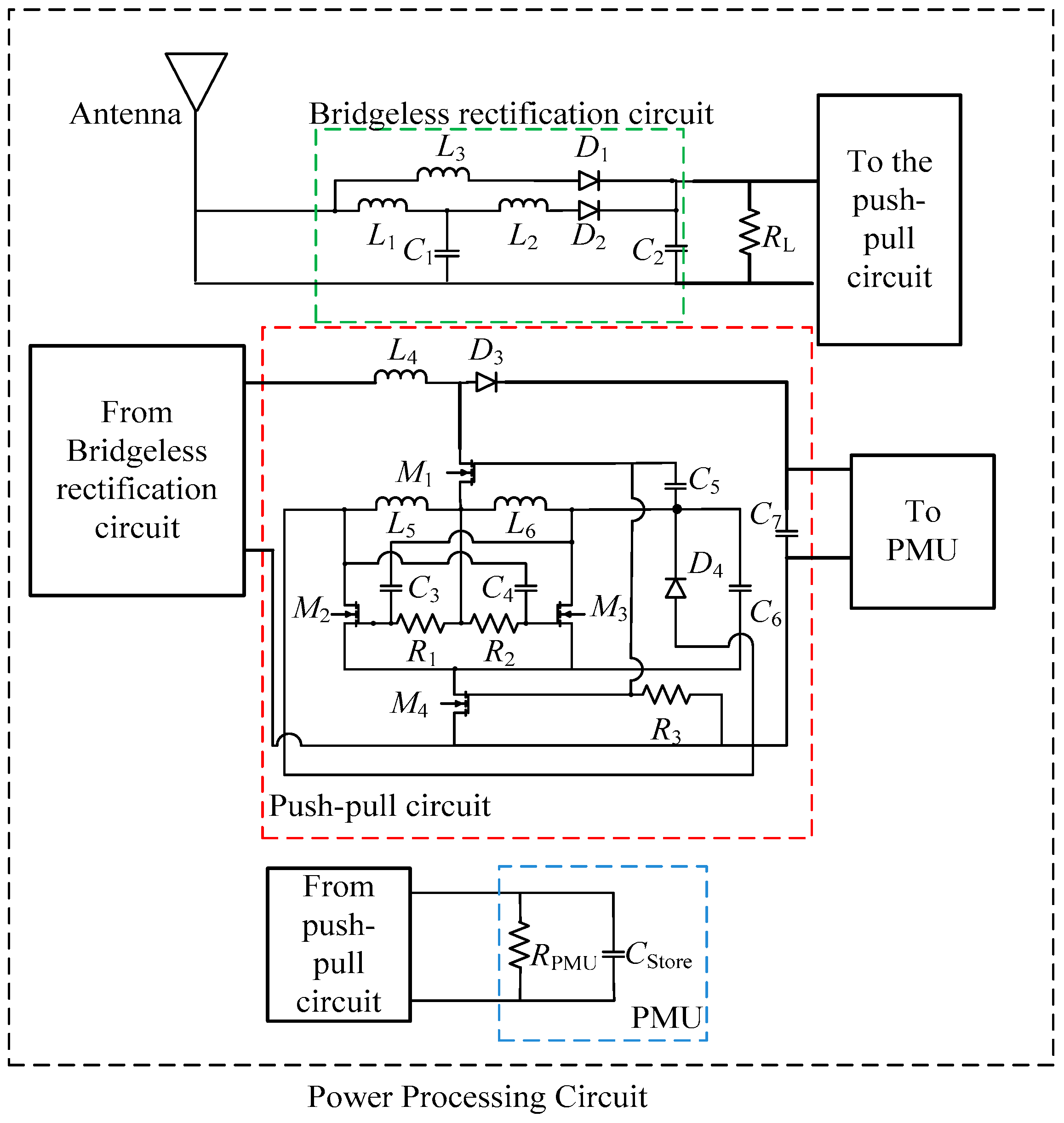
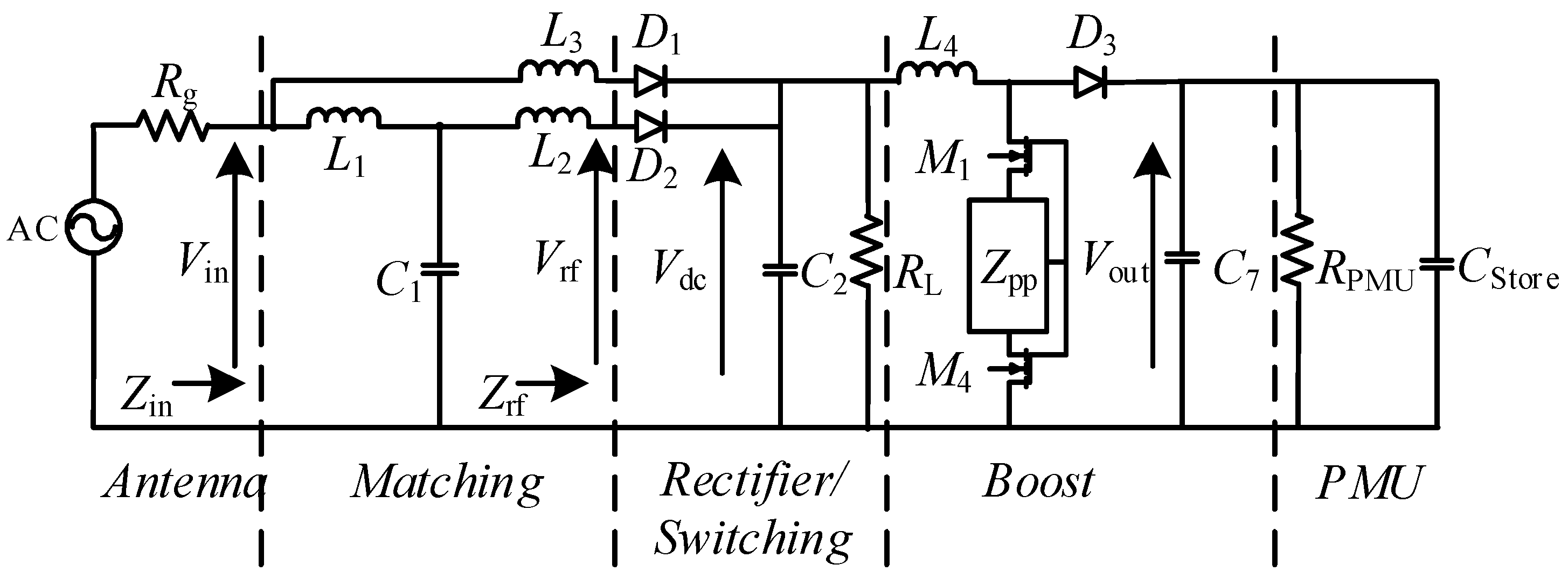
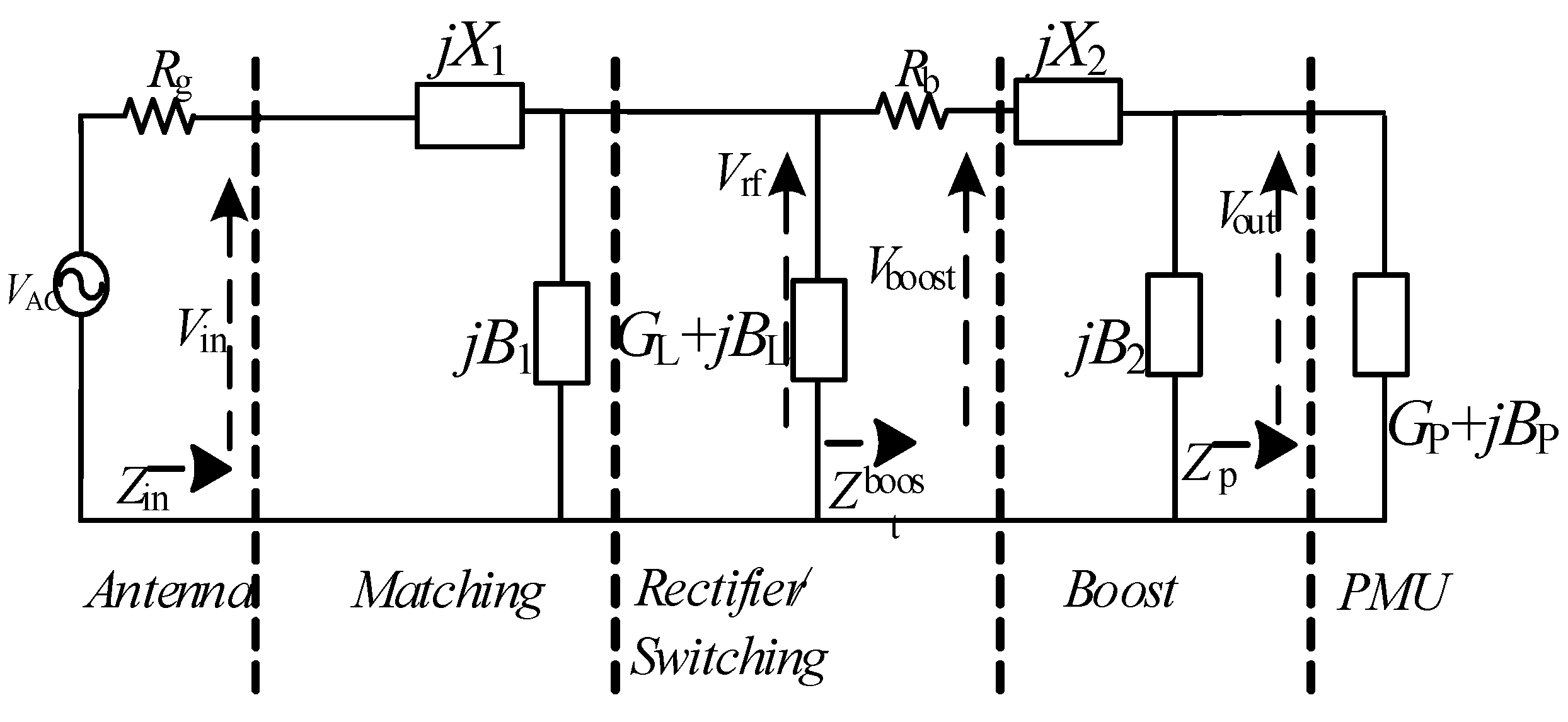
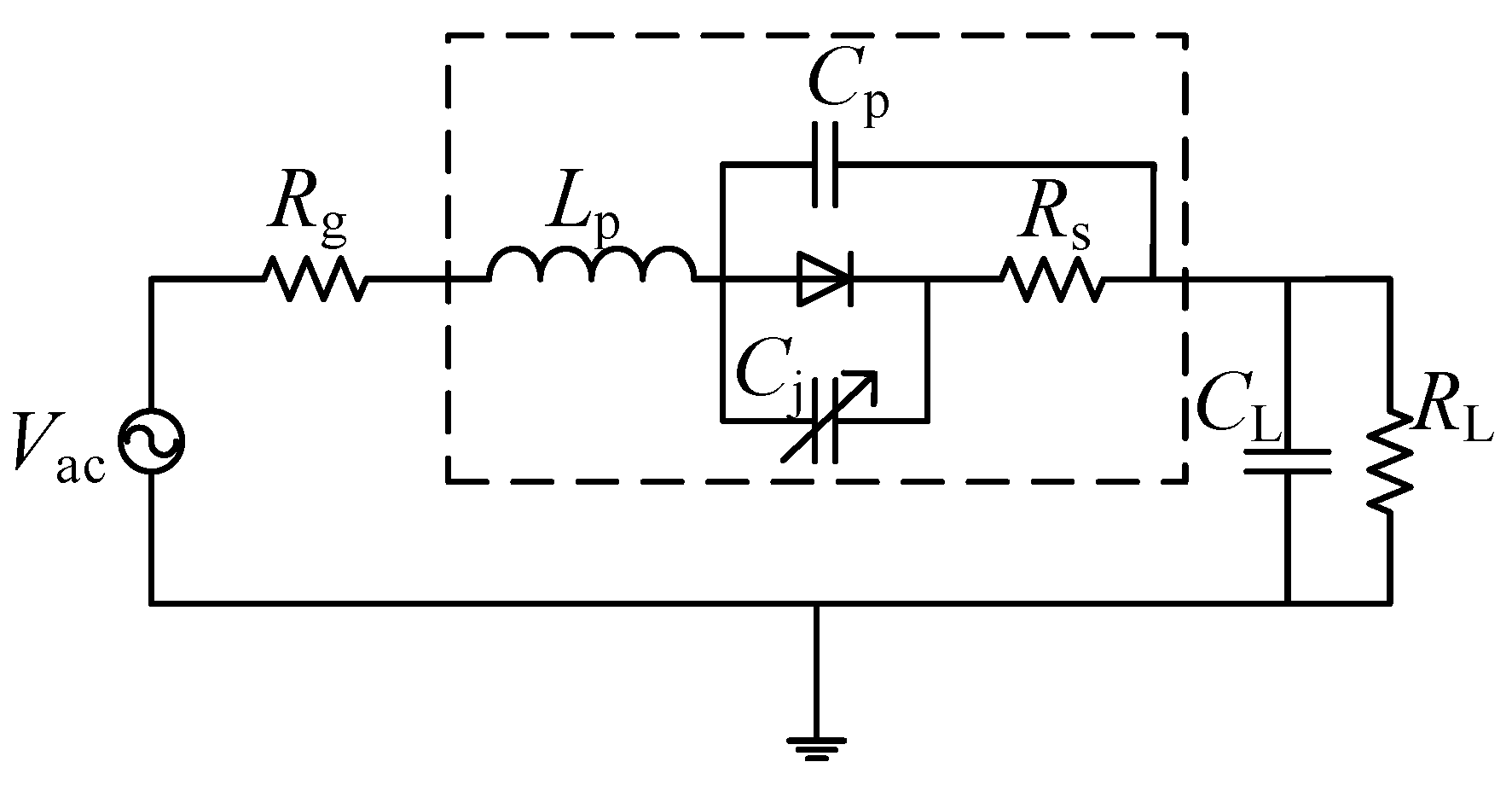

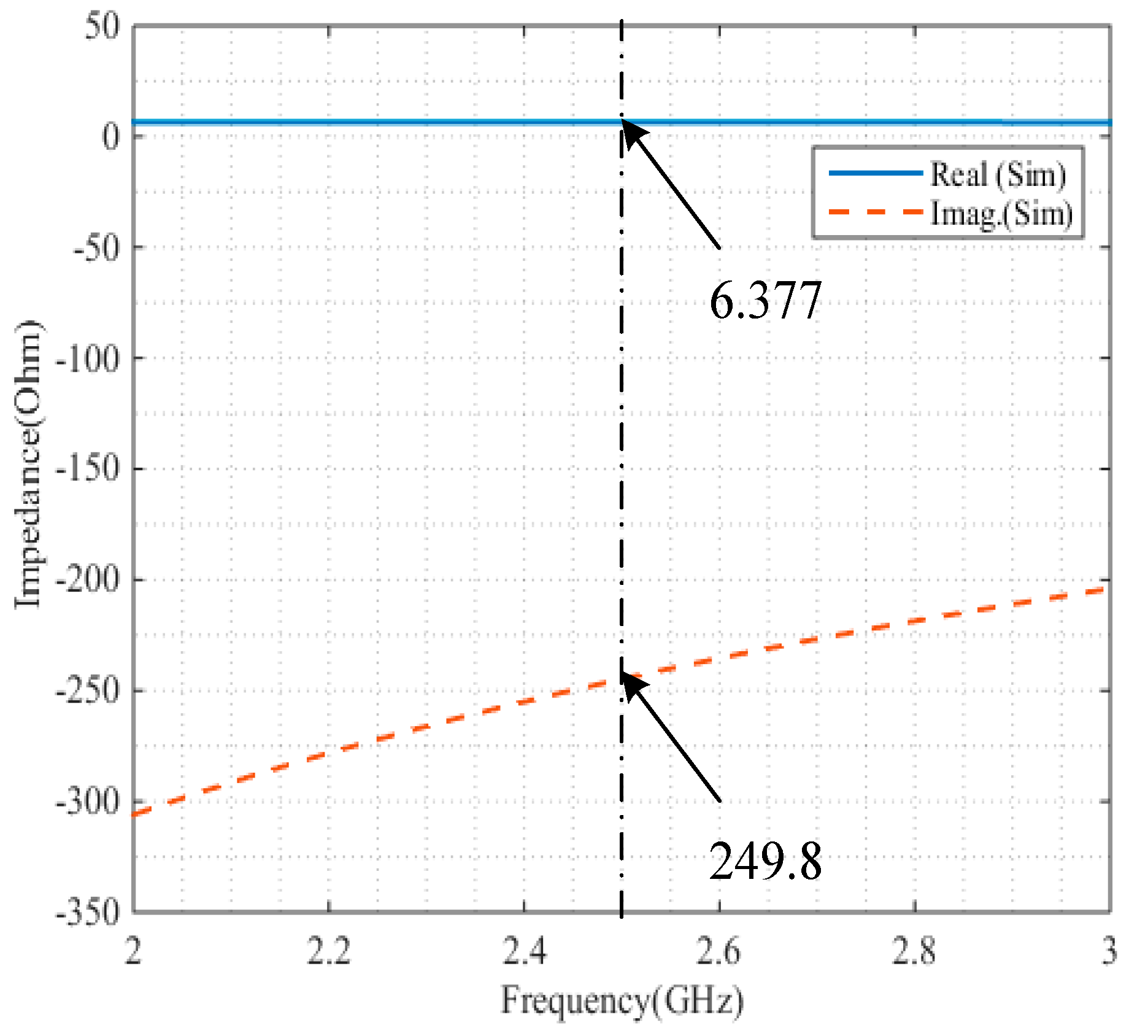
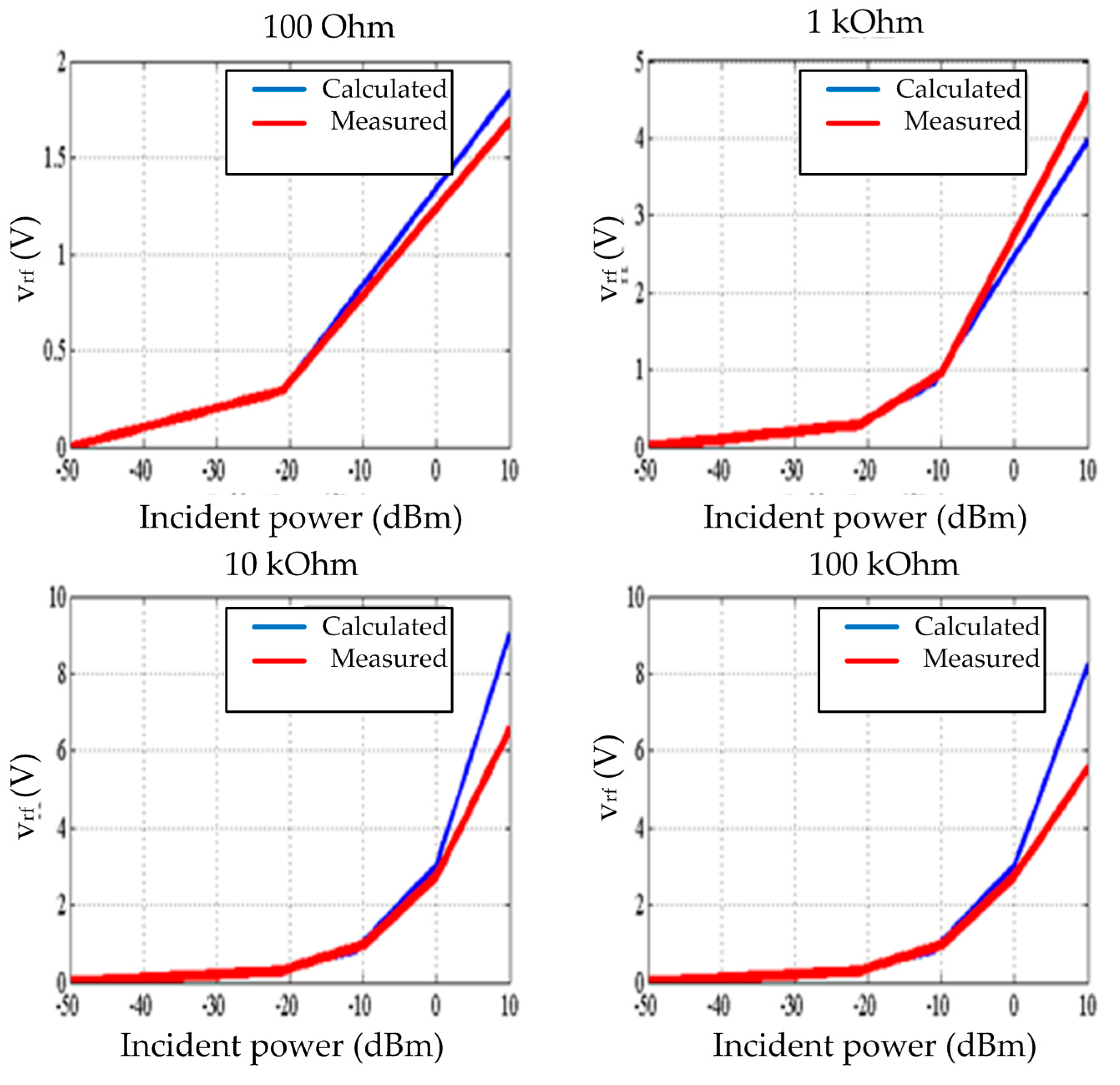
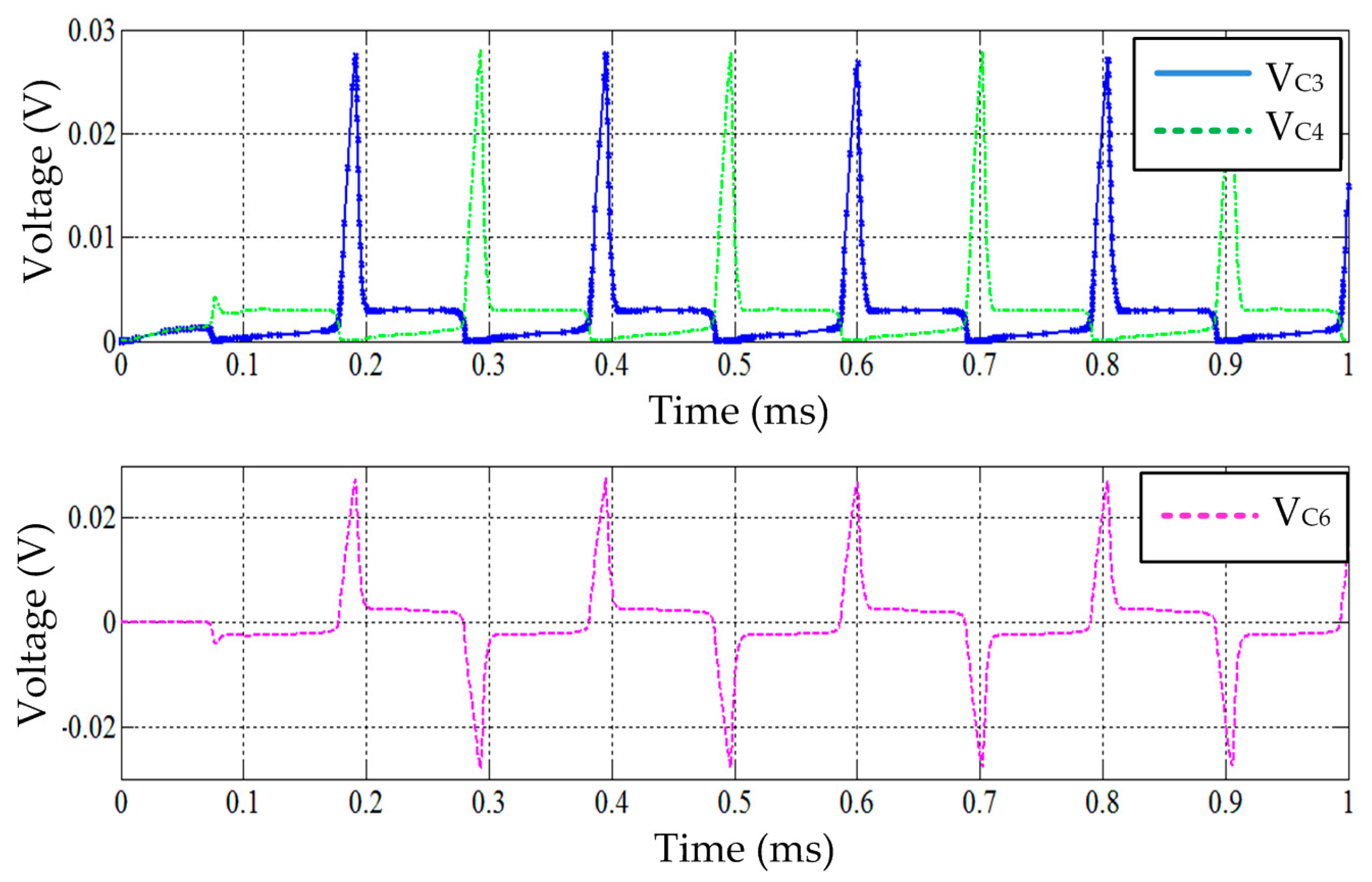
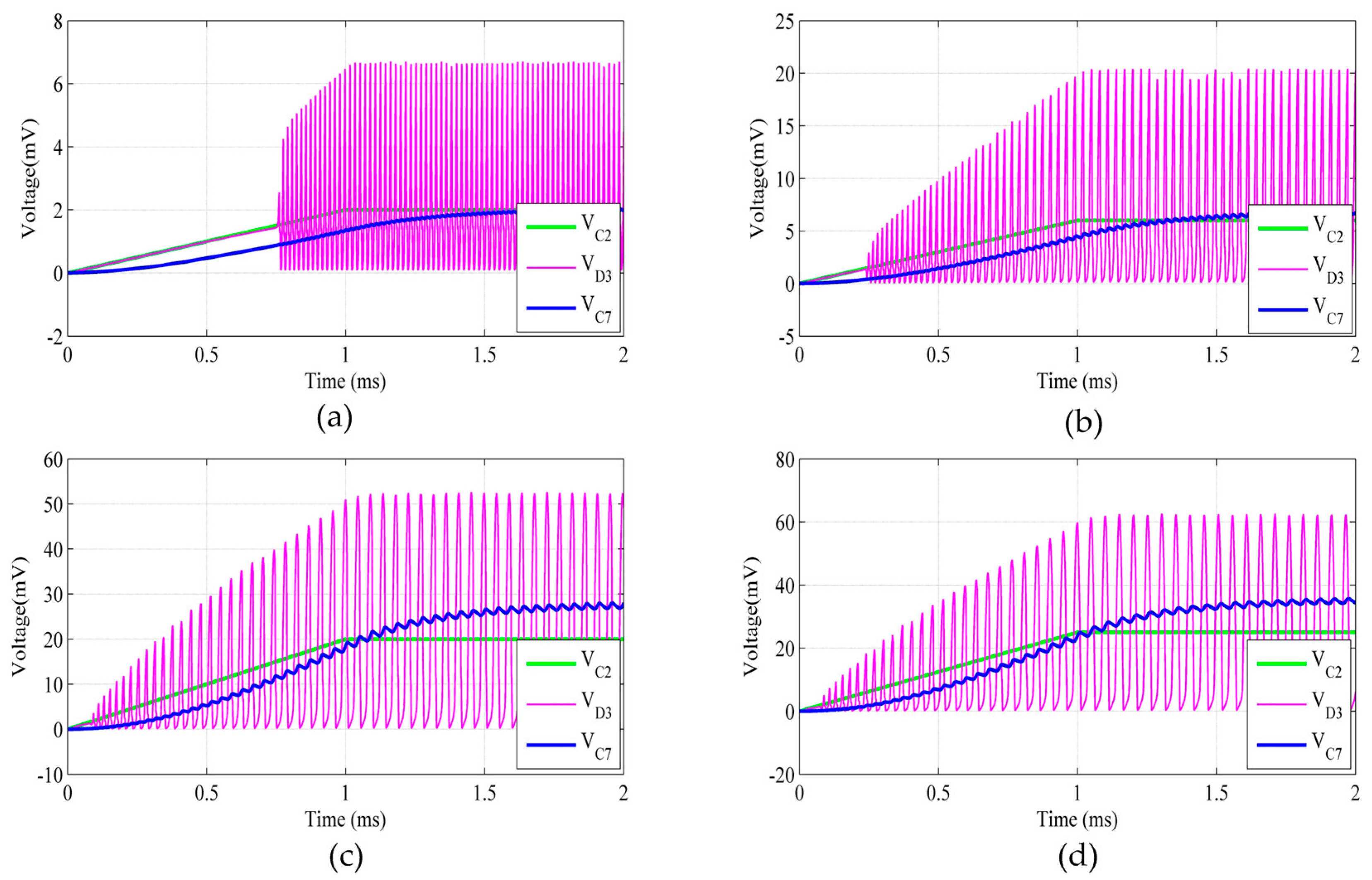

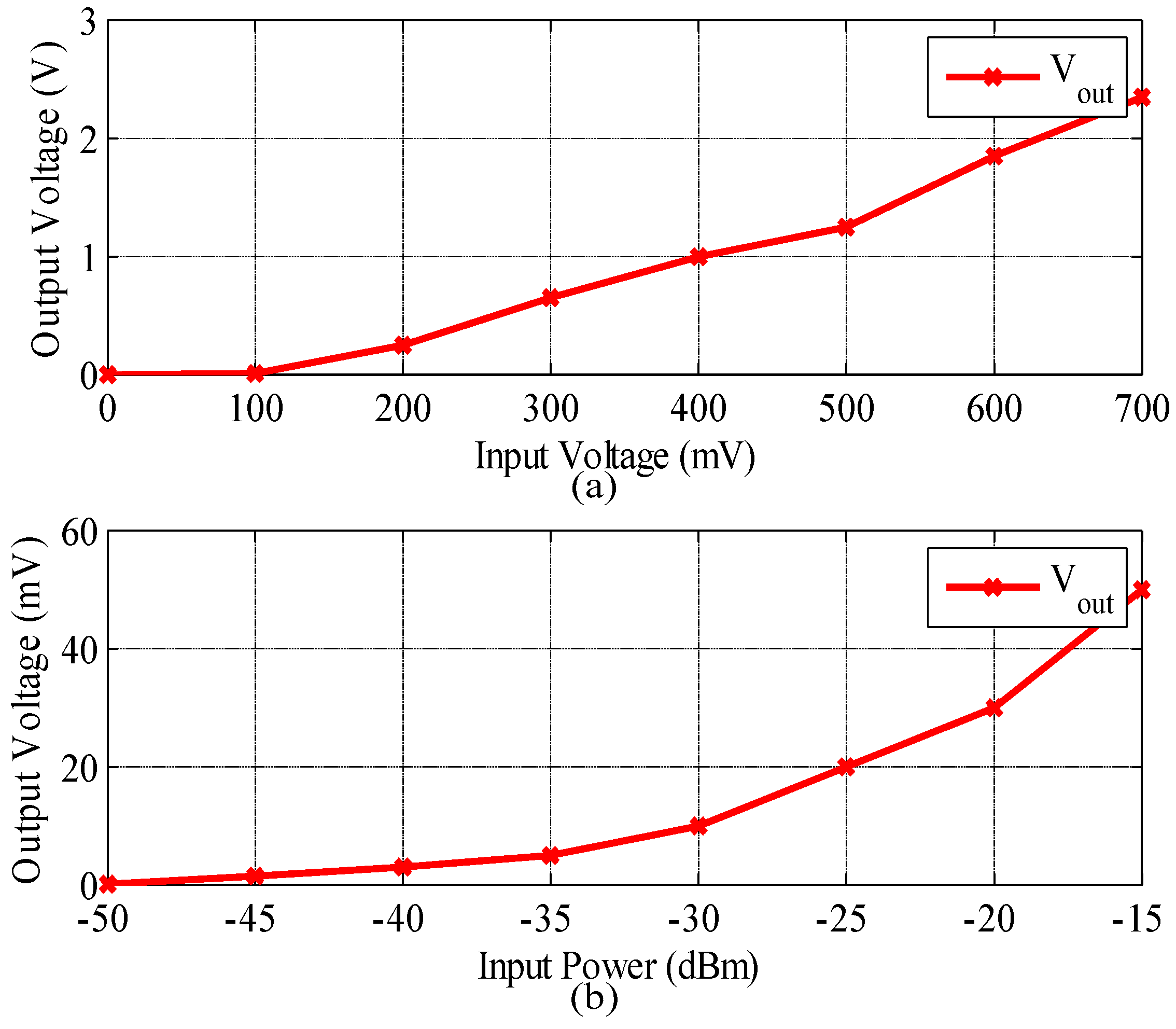
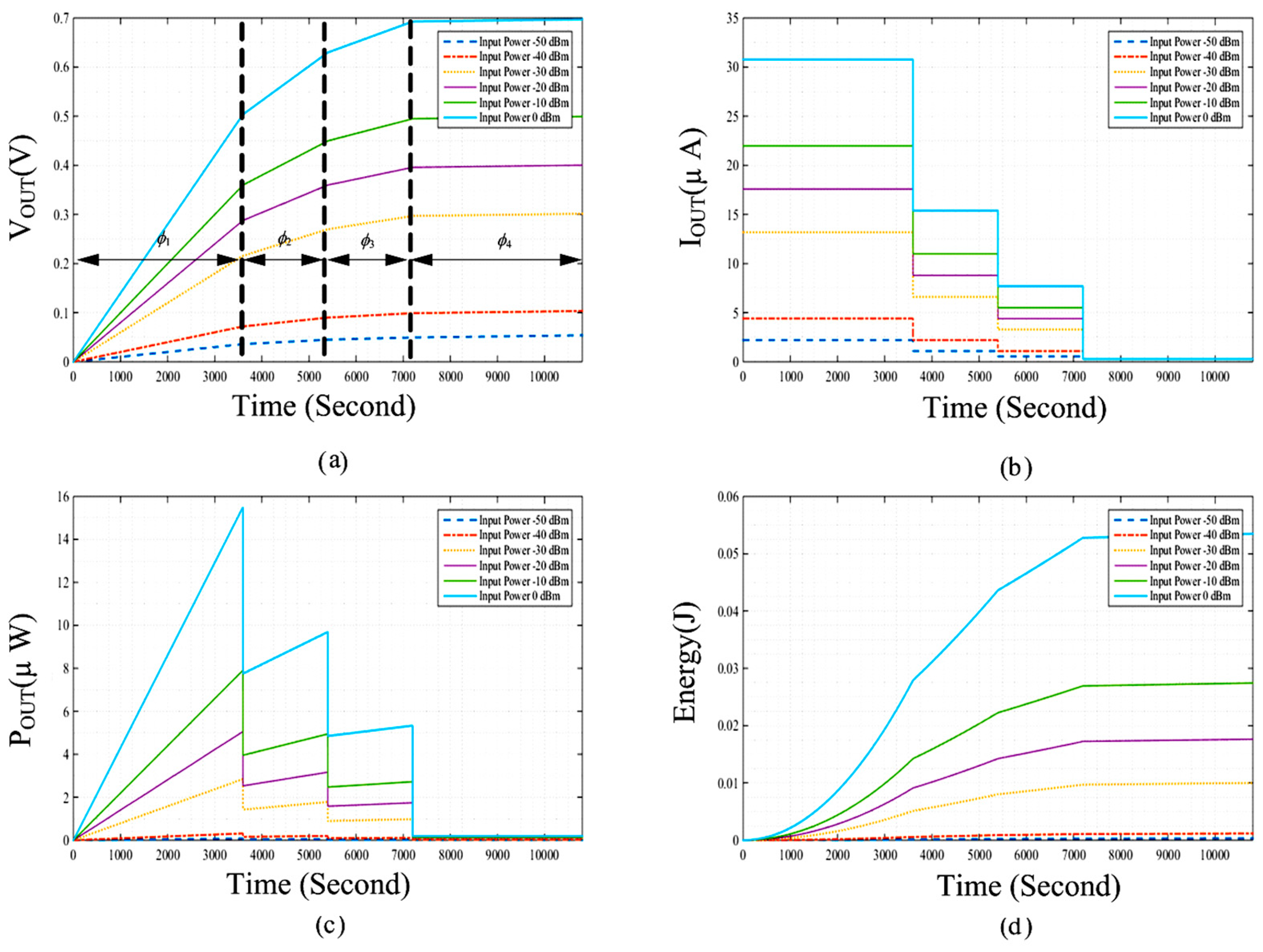
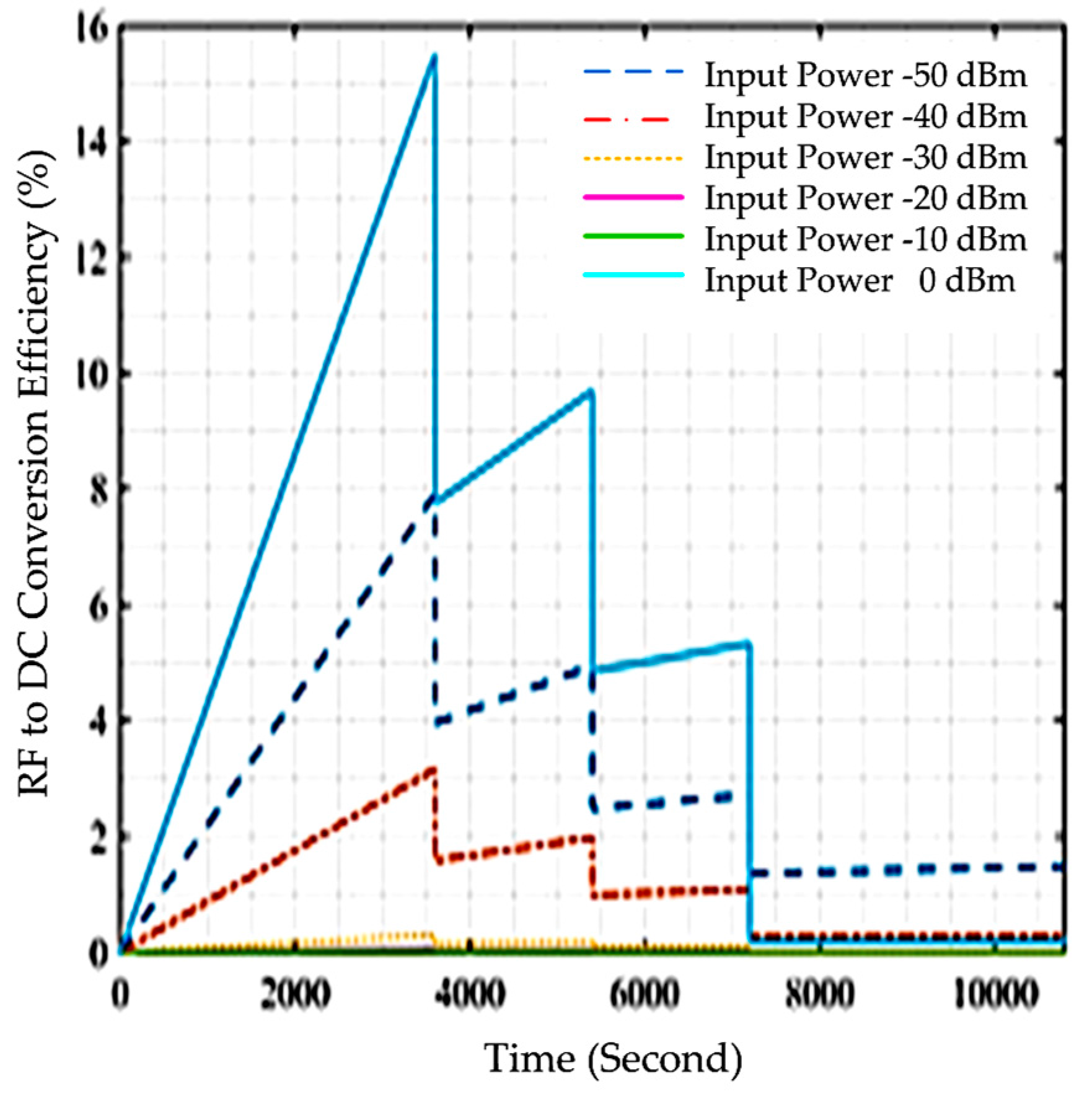
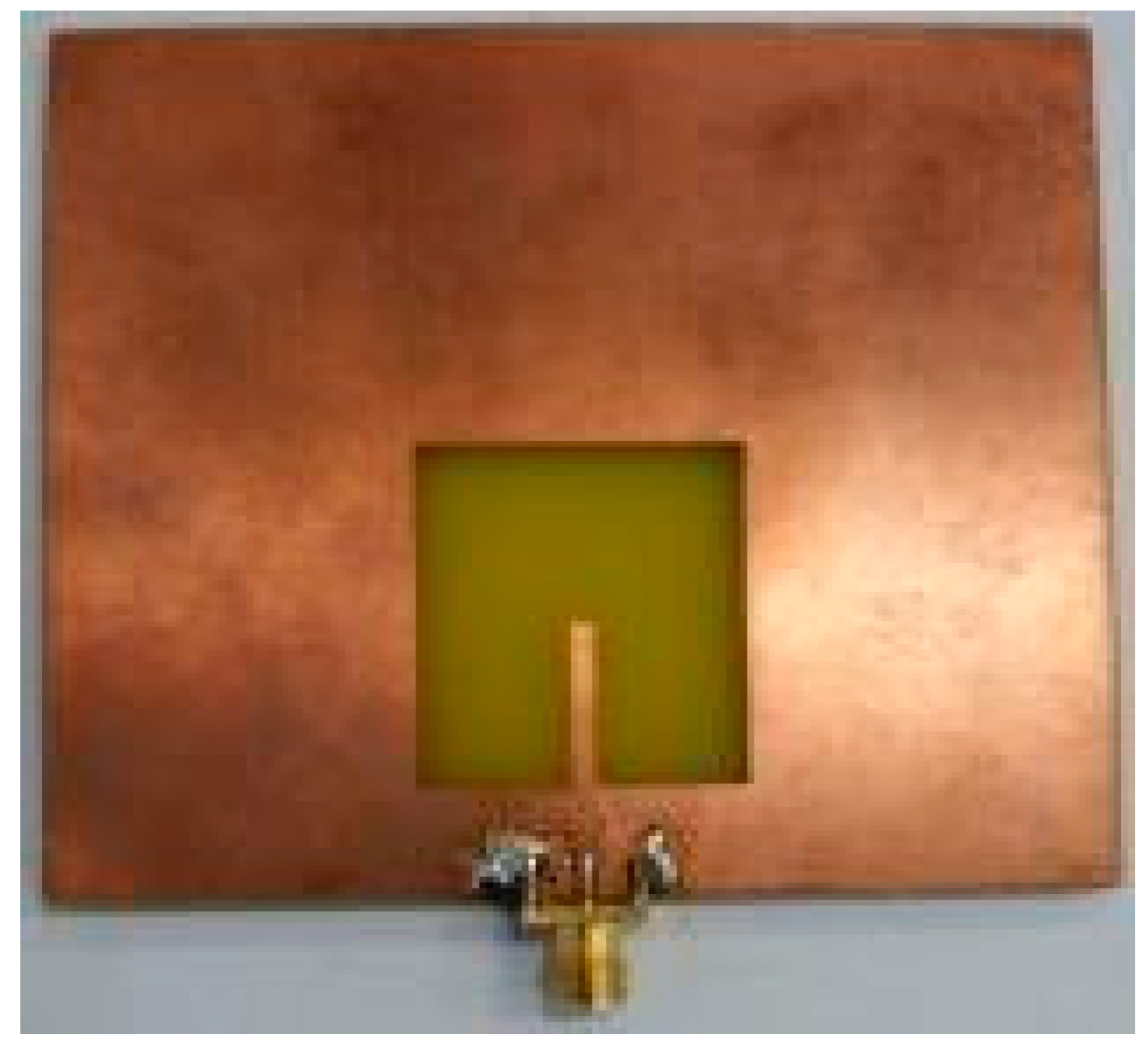
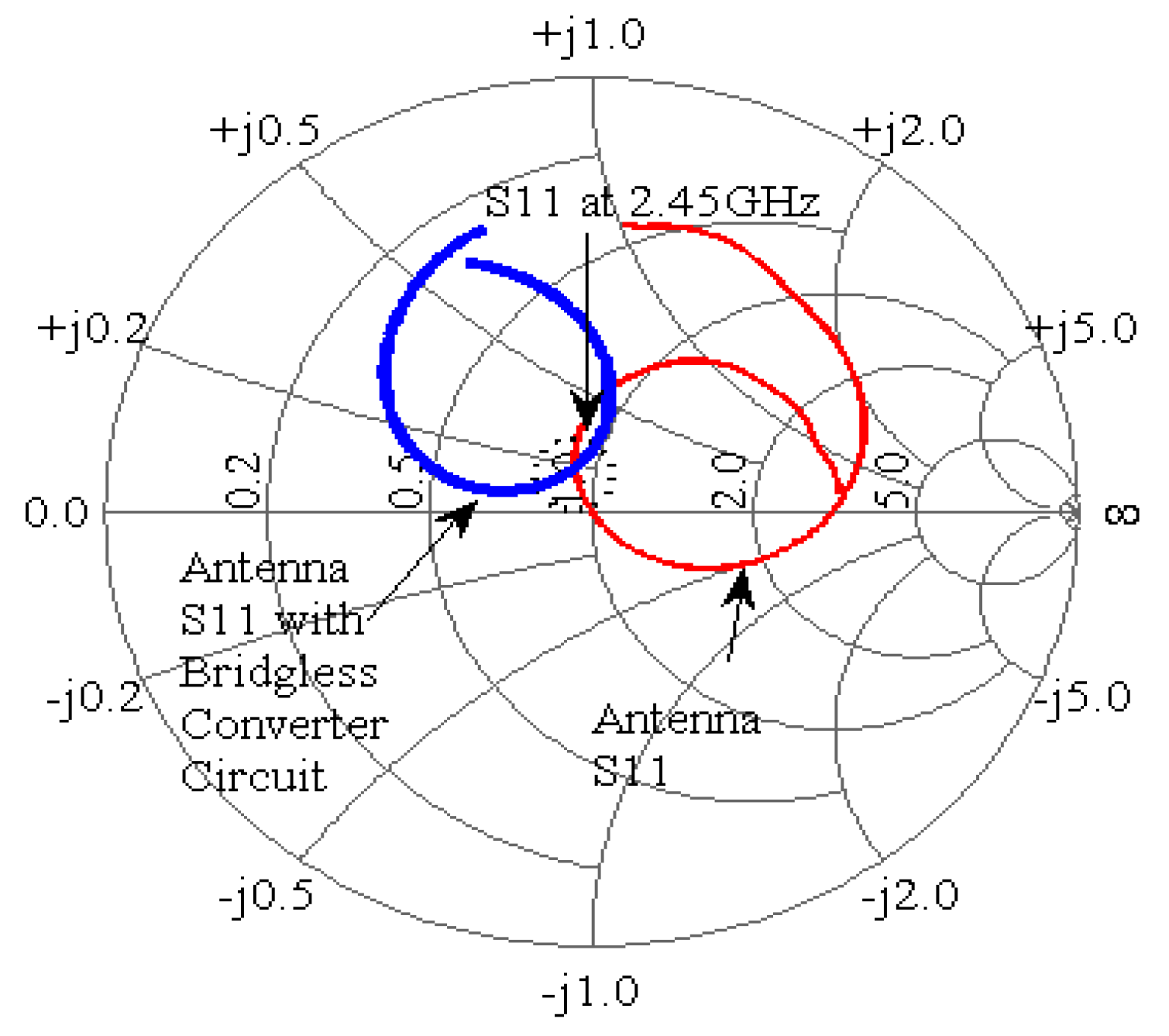
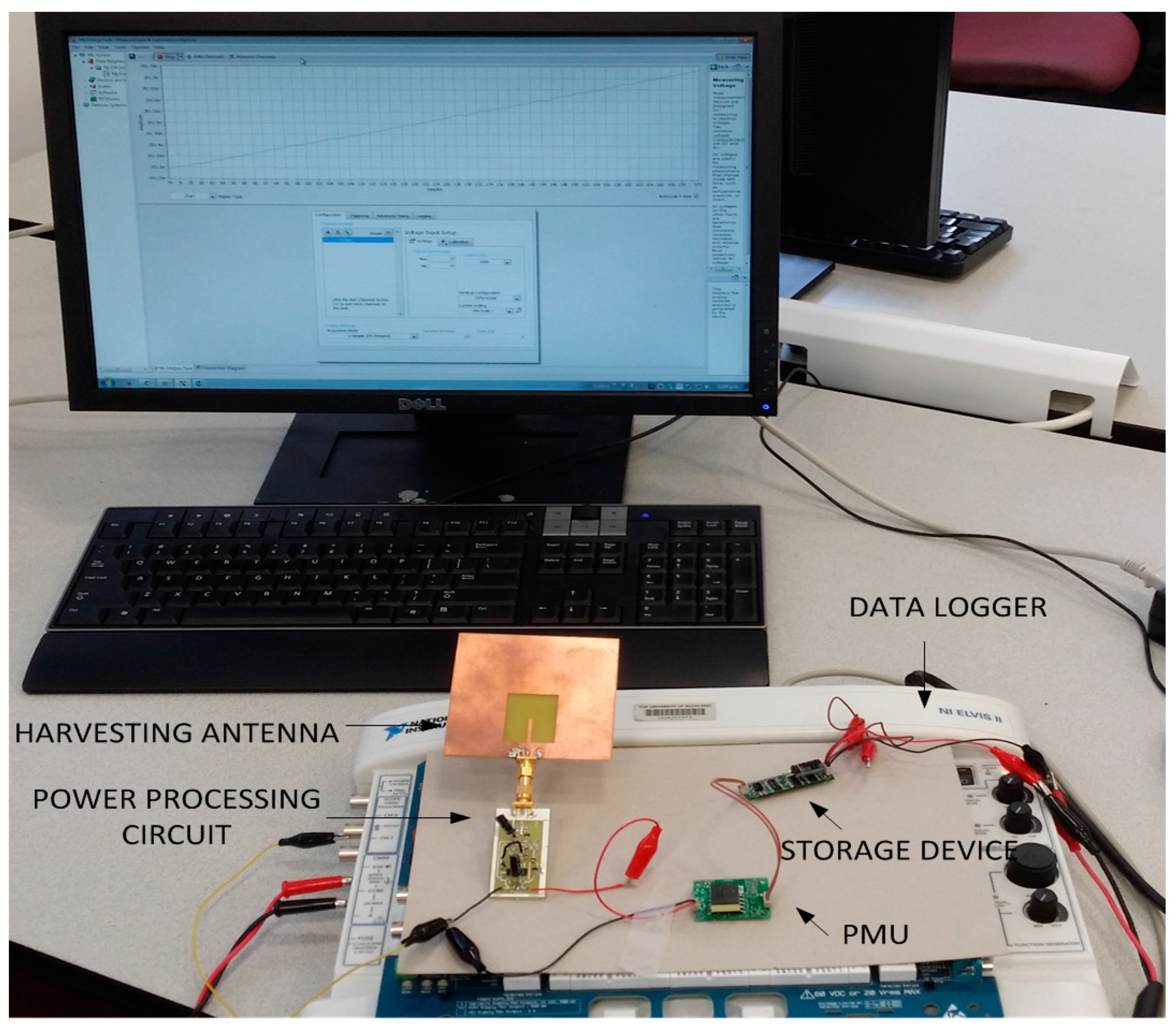
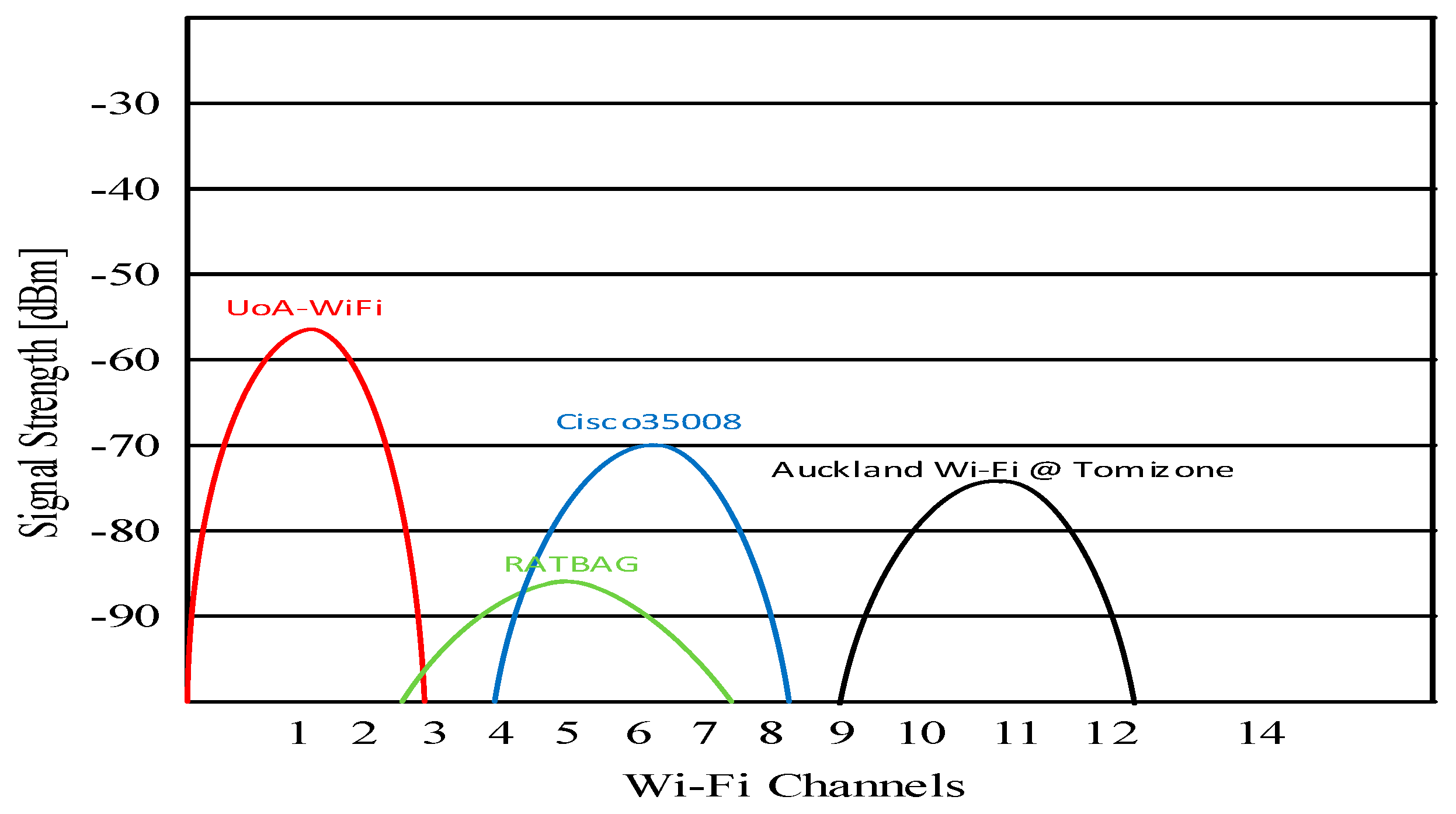

| Pcons | 110 nW | 270 nW | 450 nW | 1000 nW |
|---|---|---|---|---|
| Temperature Sensor [1] | Capacitive Sensor [2] | Biomedical Sensor [3] | Actuator Network [4] |
| Diode | Lp (nH) | Cj (pF) | Cp (pF) | Rs (Ω) | Is (µA) | n |
|---|---|---|---|---|---|---|
| HSMS2850 | 0.4 | 0.18 | 0.09 | 25 | 3 | 1.06 |
| HSMS2860 | 0.4 | 0.18 | 0.09 | 6 | 0.05 | 1.08 |
| HBAT5400 | 2 | 3.0 | 0.08 | 2.4 | 0.1 | 1.00 |
| SMS7621 | 0.2 | 0.1 | 0.05 | 12 | 0.04 | 1.05 |
| Parameter | Value | Unit | Parameter | Value | Unit |
|---|---|---|---|---|---|
| L1 | 3.0 | nH | R1, R2 | 510 | kΩ |
| L2 and L3 | 32.0 | nH | R3 | 1 | kΩ |
| C1 | 1.0 | pF | RL | 10 | kΩ |
| C2 | 10 | µF | L4-L6 | 420 | µH |
| C3-C4 | 1.0 | µF | D1-D4 | SMS7621 | - |
| C5, C6 | 4.7 | nF | M1-M4 | ALD210800A | - |
| C7 | 0.47 | µF | PMU | EH5205 | - |
| Sensor Spec. | [6] | [15] | [16] | [17] | [18] |
|---|---|---|---|---|---|
| Max.Input Supply (mV) | 1000 | 30–50 | 1000 | 600 | 1200 |
| Power Req. (nW) | 220 | 1.1–6.25 | 190 | 10.8 | 71 |
| Circuit Eqn. Impedance (Ohm) | 6.2 M | 400 k | <50 | - | 2.5 M |
| Single Band | 2.45 GHz, Wi-Fi |
|---|---|
| DC output voltage Using generator for 3 h | |
| Pin = −50 dBm Pin = −40 dBm Pin = −30 dBm Pin = −20 dBm | 50 mV 100 mV 300 mV 400 mV |
| The circuit power consumption Pin = 0 dBm | 18 nW |
| The circuit equivalent impedance | 50 kΩ |
| In indoor environment (RF power density = 0.1 mW/m2) DC output power RF-to-DC conversion efficiency | 3 µW 30% |
| Comp | This Work 2016 | [19] 2014 | [20] 2013 | [21] 2010 | [22] 2013 | [23] 2014 |
|---|---|---|---|---|---|---|
| Rect. Topology | Proposed | Series | Series | Series | Doubler | Doubler |
| Rectenna Topology | * | ** | *** | *+ | *++ | *+* |
| No. of RF band | Single | Multi | Single | Double | Double | Five |
| RF bands (GHz) | 2.45 Wi-Fi | 0.9, 1.8, 2.1, 2.45 | 0.45 | 0.9, 1.8 | 0.9, 2.0 | 0.267, 0.4, 0.47, 0.9, 1.35 |
| RF-to-DC Efficiency | 6–30% −20 dBm | 15% −20 dBm | 45% −10 dBm | 4% (for each band) 12 dBm | 9.1% and 8.9% −19 dBm | 19%, 20%, 16%, 5% −10 dBm |
| RF source and distance | Ambient RF | Dedicated RF 50 m | Dedicated 70 cm | Dedicated 3.75 m | - | Dedicated 4 m |
© 2017 by the authors. Licensee MDPI, Basel, Switzerland. This article is an open access article distributed under the terms and conditions of the Creative Commons Attribution (CC BY) license (http://creativecommons.org/licenses/by/4.0/).
Share and Cite
Kadir, E.A.; Hu, A.P. A Power Processing Circuit for Indoor Wi-Fi Energy Harvesting for Ultra-Low Power Wireless Sensors. Appl. Sci. 2017, 7, 827. https://doi.org/10.3390/app7080827
Kadir EA, Hu AP. A Power Processing Circuit for Indoor Wi-Fi Energy Harvesting for Ultra-Low Power Wireless Sensors. Applied Sciences. 2017; 7(8):827. https://doi.org/10.3390/app7080827
Chicago/Turabian StyleKadir, Ermeey Abd, and Aiguo Patrick Hu. 2017. "A Power Processing Circuit for Indoor Wi-Fi Energy Harvesting for Ultra-Low Power Wireless Sensors" Applied Sciences 7, no. 8: 827. https://doi.org/10.3390/app7080827




